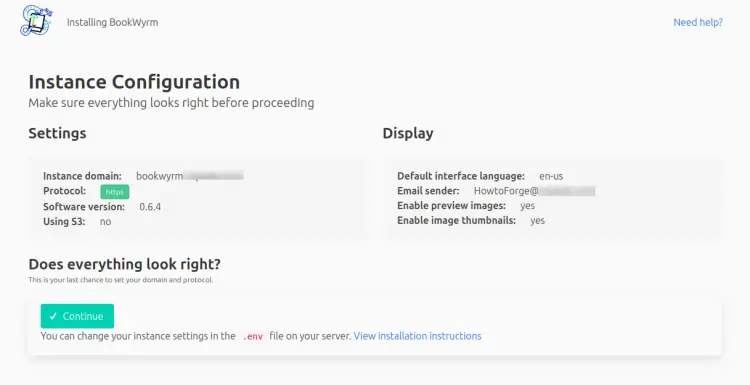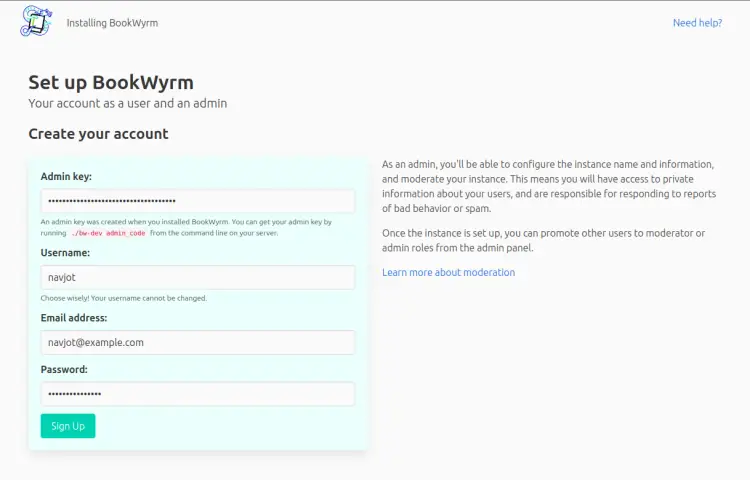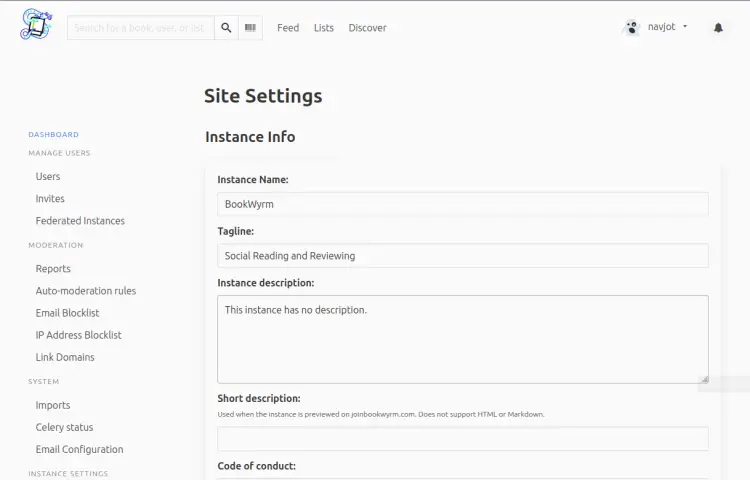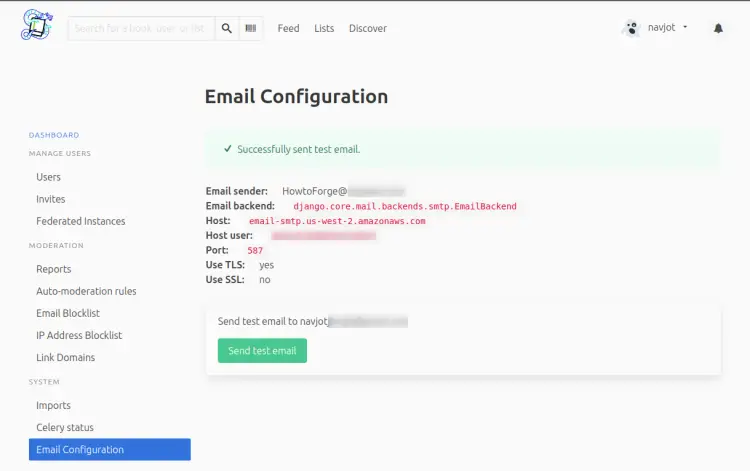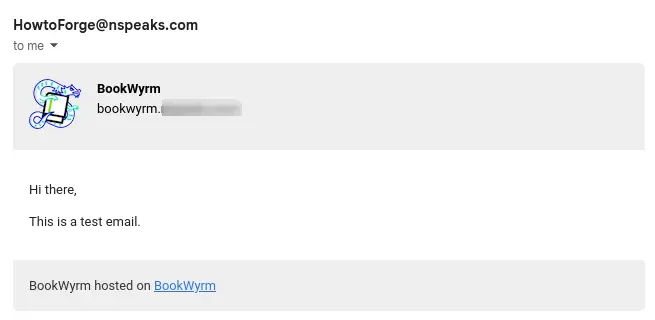How to Install BookWyrm on a Debian 12 server
On this page
- Prerequisites
- Step 1 - Configure Firewall
- Step 2 - Install and Configure PostgreSQL
- Step 3 - Install Redis
- Step 4 - Install Nginx
- Step 5 - Install SSL
- Step 6 - Download BookWyrm
- Step 7 - Configure BookWyrm
- Step 8 - Configure Nginx
- Step 9 - Install BookWyrm
- Step 10 - Access BookWyrm
- Step 11 - Backup BookWyrm
- Step 12 - Update BookWyrm
- Conclusion
BookWyrm is an open-source federated social network for book readers. It acts as an ad-free Goodreads alternative. It uses the ActivityPub protocol to send and receive user activity between other BookWyrm instances and other services that use the protocol like Mastodon. It offers a lot of features like book reviews, ratings, reading activity, book shelves such as "to-read", "currently-reading" and "read", book lists, and following other users and their reading progress. It also offers user moderation features like blocking or manually approving followers and multiple privacy levels for statuses, shelves, and lists.
In this tutorial, you will learn how to install BookWyrm federated social network for book readers on a Debian 12 server.
Prerequisites
-
A server running Debian 12.
-
A non-root user with sudo privileges.
-
A Fully Qualified Domain Name (FQDN) like
bookwyrm.example.compointing to your server. -
An SMTP account with an email service like Amazon SES or Mailgun.
-
Make sure everything is updated.
$ sudo apt update $ sudo apt upgrade
-
Few packages that your system needs.
$ sudo apt install wget curl nano ufw software-properties-common dirmngr apt-transport-https gnupg2 ca-certificates lsb-release debian-archive-keyring unzip -y
Some of these packages may already be installed on your system.
Step 1 - Configure Firewall
The first step is to configure the firewall. Debian comes with ufw (Uncomplicated Firewall) by default.
Check if the firewall is running.
$ sudo ufw status
You will get the following output.
Status: inactive
Allow SSH port so that the firewall doesn't break the current connection upon enabling it.
$ sudo ufw allow OpenSSH
Allow HTTP and HTTPS ports as well.
$ sudo ufw allow http $ sudo ufw allow https
Enable the Firewall
$ sudo ufw enable Command may disrupt existing ssh connections. Proceed with operation (y|n)? y Firewall is active and enabled on system startup
Check the status of the firewall again.
$ sudo ufw status
You should see a similar output.
Status: active To Action From -- ------ ---- OpenSSH ALLOW Anywhere 80/tcp ALLOW Anywhere 443 ALLOW Anywhere OpenSSH (v6) ALLOW Anywhere (v6) 80/tcp (v6) ALLOW Anywhere (v6) 443 (v6) ALLOW Anywhere (v6)
Step 2 - Install and Configure PostgreSQL
Ubuntu 22.04 ships with PostgreSQL 14 by default. We will be using PostgreSQL 15 instead.
Run the following command to add the PostgreSQL GPG key.
$ curl https://www.postgresql.org/media/keys/ACCC4CF8.asc | gpg --dearmor | sudo tee /usr/share/keyrings/postgresql-key.gpg >/dev/null
Add the APT repository to your sources list.
$ sudo sh -c 'echo "deb [signed-by=/usr/share/keyrings/postgresql-key.gpg arch=amd64] http://apt.postgresql.org/pub/repos/apt $(lsb_release -cs)-pgdg main" > /etc/apt/sources.list.d/pgdg.list'
Update the system repository.
$ sudo apt update
Now, you can install PostgreSQL using the command below.
$ sudo apt install postgresql postgresql-contrib
The postgresql-contrib package contains some extra utilities.
Check the status of the PostgreSQL service.
$ sudo systemctl status postgresql
? postgresql.service - PostgreSQL RDBMS
Loaded: loaded (/lib/systemd/system/postgresql.service; enabled; preset: enabled)
Active: active (exited) since Sat 2023-09-09 07:39:21 UTC; 16s ago
Main PID: 3653 (code=exited, status=0/SUCCESS)
CPU: 1ms
Sep 09 07:39:21 bookwyrm systemd[1]: Starting postgresql.service - PostgreSQL RDBMS...
Sep 09 07:39:21 bookwyrm systemd[1]: Finished postgresql.service - PostgreSQL RDBMS.
You can see that the service is enabled and running by default.
Launch the PostgreSQL shell.
$ sudo -i -u postgres psql
Create the BookWyrm database.
postgres=# CREATE DATABASE bookwyrm TEMPLATE template0 ENCODING 'UNICODE';
Create the BookWyrm user and choose a strong password.
postgres-# CREATE USER bookwyrmuser WITH PASSWORD 'Your_Password';
Change the database owner to the BookWyrm user.
postgres-# ALTER DATABASE bookwyrm OWNER TO bookwyrmuser;
Grant all privileges on the database to the BookWyrm user.
postgres-# GRANT ALL PRIVILEGES ON DATABASE bookwyrm TO bookwyrmuser;
Exit the shell.
postgres-# \q
Verify that your credentials work.
$ psql --username bookwyrmuser --password --host localhost bookwyrm Password: psql (15.4 (Debian 15.4-1.pgdg120+1)) SSL connection (protocol: TLSv1.3, cipher: TLS_AES_256_GCM_SHA384, compression: off) Type "help" for help. bookwyrm=>
Exit the shell by typing \q.
Step 3 - Install Redis
Magento uses Redis for session and cache storage. It is entirely optional and you can use the database for session storage. But Redis does a better job. The latest version of Magento works with Redis 7.0. Ubuntu ships with Redis 6.0 so we will use the Redis repository for installation.
Import the official Redis GPG key.
$ curl -fsSL https://packages.redis.io/gpg | sudo gpg --dearmor -o /usr/share/keyrings/redis-archive-keyring.gpg
Add the APT repository to your sources list.
$ echo "deb [signed-by=/usr/share/keyrings/redis-archive-keyring.gpg] https://packages.redis.io/deb $(lsb_release -cs) main" | sudo tee /etc/apt/sources.list.d/redis.list
Update the system repository list.
$ sudo apt update
Issue the following command to install the Redis server.
$ sudo apt install redis
Confirm the Redis version.
$ redis-server -v Redis server v=7.2.1 sha=00000000:0 malloc=jemalloc-5.3.0 bits=64 build=95712a67f5005c28
Let us verify the service connection by using the following command.
$ redis-cli
You will be switched to the Redis shell.
The first step is to set the password for the Redis default user. Replace Your_Redis_Password with a strong password of your choice. Make sure you prefix the password with the > character.
127.0.0.1:6379> acl setuser default >Your_Redis_Password
Test the Redis Authentication.
127.0.0.1:6379> AUTH Your_Redis_Password OK
Ping the service.
127.0.0.1:6379> ping PONG
Exit the service by typing exit.
If you want, you can use the following command to generate the Redis password.
$ openssl rand 60 | openssl base64 -A OaYOuq6J9HhxMV0sGCeZbaGecphCl4GBfVkCOPkNjkQE1FX9DKpGSCJcDb8UV+AuFKA8tR1PgjGequn1
Step 4 - Install Nginx
Debian 12 ships with an older version of Nginx. To install the latest version, you need to download the official Nginx repository.
Import Nginx's signing key.
$ curl https://nginx.org/keys/nginx_signing.key | gpg --dearmor \
| sudo tee /usr/share/keyrings/nginx-archive-keyring.gpg >/dev/null
Add the repository for Nginx's stable version.
$ echo "deb [signed-by=/usr/share/keyrings/nginx-archive-keyring.gpg] \
http://nginx.org/packages/debian `lsb_release -cs` nginx" \
| sudo tee /etc/apt/sources.list.d/nginx.list
Update the system repositories.
$ sudo apt update
Install Nginx.
$ sudo apt install nginx
Verify the installation. On Debian systems, the following command will only work with sudo.
$ sudo nginx -v nginx version: nginx/1.24.0
Start the Nginx server.
$ sudo systemctl start nginx
Check the service status.
$ sudo systemctl status nginx
? nginx.service - nginx - high performance web server
Loaded: loaded (/lib/systemd/system/nginx.service; enabled; preset: enabled)
Active: active (running) since Sat 2023-09-09 08:40:27 UTC; 1s ago
Docs: https://nginx.org/en/docs/
Process: 6946 ExecStart=/usr/sbin/nginx -c /etc/nginx/nginx.conf (code=exited, status=0/SUCCESS)
Main PID: 6947 (nginx)
Tasks: 2 (limit: 1107)
Memory: 1.7M
CPU: 8ms
CGroup: /system.slice/nginx.service
??6947 "nginx: master process /usr/sbin/nginx -c /etc/nginx/nginx.conf"
??6948 "nginx: worker process"
Step 5 - Install SSL
We need to install Certbot to generate the SSL certificate. You can either install Certbot using Debian's repository or grab the latest version using the Snapd tool. We will be using the Snapd version.
Debian 12 comes doesn't come with Snapd installed. Install Snapd package.
$ sudo apt install snapd
Run the following commands to ensure that your version of Snapd is up to date.
$ sudo snap install core && sudo snap refresh core
Install Certbot.
$ sudo snap install --classic certbot
Use the following command to ensure that the Certbot command can be run by creating a symbolic link to the /usr/bin directory.
$ sudo ln -s /snap/bin/certbot /usr/bin/certbot
Verify if Certbot is functioning correctly.
$ certbot --version certbot 2.6.0
Generate the SSL certificate.
$ sudo certbot certonly --nginx --agree-tos --no-eff-email --staple-ocsp --preferred-challenges http -m name@example.com -d bookwyrm.example.com
The above command will download a certificate to the /etc/letsencrypt/live/bookwyrm.example.com directory on your server.
Generate a Diffie-Hellman group certificate.
$ sudo openssl dhparam -dsaparam -out /etc/ssl/certs/dhparam.pem 4096
Check the Certbot renewal scheduler service.
$ sudo systemctl list-timers
You will find snap.certbot.renew.service as one of the services scheduled to run.
NEXT LEFT LAST PASSED UNIT ACTIVATES ---------------------------------------------------------------------------------------------------------------- Sat 2023-09-09 23:49:00 UTC 15h left - - snap.certbot.renew.timer snap.certbot.renew.service Sun 2023-09-10 00:00:00 UTC 15h left - - dpkg-db-backup.timer dpkg-db-backup.service Sun 2023-09-10 00:00:00 UTC 15h left Sat 2023-09-09 06:42:47 UTC 2h 1min ago exim4-base.timer exim4-base.service
Do a dry run of the process to check whether the SSL renewal is working fine.
$ sudo certbot renew --dry-run
If you see no errors, you are all set. Your certificate will renew automatically.
Step 6 - Download BookWyrm
Create a directory for BookWyrm.
$ sudo mkdir /opt/bookwyrm
Switch to the directory.
$ cd /opt/bookwyrm
Clone the BookWyrm application's production branch from GitHub.
$ sudo git clone https://github.com/bookwyrm-social/bookwyrm.git --branch production --single-branch ./
Create the environment file by copying the example file.
$ sudo cp .env.example .env
Step 7 - Configure BookWyrm
Generate a secret key for BookWyrm.
$ openssl rand 60 | openssl base64 -A wcMjI1FW0mL9RfyxYDNZE/8bQP88kVIAUh7ekcSNAOUQCVfNeuMeW3und4BO5WbyCYy+9KpHqoEHWCkl
Open the environment file for editing.
$ sudo nano .env
Configure the following variables.
SECRET_KEY="wcMjI1FW0mL9RfyxYDNZE/8bQP88kVIAUh7ekcSNAOUQCVfNeuMeW3und4BO5WbyCYy+9KpHqoEHWCkl" DOMAIN=bookwyrm.example.com EMAIL=user@example.com POSTGRES_PASSWORD=Your_Password POSTGRES_USER=bookwyrmuser POSTGRES_DB=bookwyrm POSTGRES_HOST=localhost REDIS_ACTIVITY_HOST=localhost REDIS_ACTIVITY_PORT=6379 REDIS_ACTIVITY_PASSWORD=Your_Redis_Password REDIS_ACTIVITY_DB_INDEX=0 REDIS_BROKER_HOST=localhost REDIS_BROKER_PORT=6379 REDIS_BROKER_PASSWORD=Your_Redis_Password REDIS_BROKER_DB_INDEX=1 FLOWER_USER=username FLOWER_PASSWORD=flowerpassword EMAIl_HOST= EMAIL_PORT=587 EMAIL_HOST_USER=AmazonSESUSER EMAIL_HOST_PASSWORD=AmazonSESPASSWORD EMAIL_USE_TLS=true EMAIL_USE_SSL=false EMAIL_SENDER_NAME=HowtoForge EMAIL_SENDER_DOMAIN=example.com ## only enable it if you have a fairly powered server with a minimum of 2 CPU Cores and 2GB of RAM ENABLE_PREVIEW_IMAGES=true
Let us go through all the variables in the environment file.
SECRET_KEY- the key which you generated aboveDOMAIN- the fully qualified domain name (FQDN) for your BookWyrn instance. In our case, it would bebookwyrm.example.com.POSTGRES_PASSWORD- PostgreSQL password configured in step 2.POSTGRES_HOST- set tolocalhostif you are hosting it on the same machine.POSTGRES_USER- set tobookwyrmuserwhich you chose in step 2.POSTGRES_DB- set tobookwyrmas chosen in step 2.REDIS_ACTIVITY_HOSTandREDIS_BROKER_HOST- set them to localhost if you are hosting the Redis server on the same machine.REDIS_ACTIVITY_PORTandREDIS_BROKER_PORT- set them to the default Redis port 6379.REDIS_ACTIVITY_DBandREDIS_BROKER_DB- set them to 0 and 1 respectively. We will use different databases for both.REDIS_ACTIVITY_PASSWORDandREDIS_BROKER_PASSWORD- set them to the Redis password as chosen in step 3.FLOWER_USER- choose a username for the Flower service which is needed by BookWyrm.FLOWER_PASSWORD- choose a password for the Flower service.EMAIL_HOST- set to the SMTP host of the email service you are using.EMAIL_PORT- set to the SMTP port of the email service.EMAIL_HOST_USER- set to the SMTP username.EMAIL_HOST_PASSWORD- set to the SMTP password.EMAIL_USE_TLS- set it to true if your email service uses TLS.EMAIL_USE_SSL- set it to true if your email service uses SSL.EMAIL_SENDER_NAME- choose the name of the sender for the emails sent by your instance.EMAIL_SENDER_DOMAIN- set it to the domain name used by the email service.ENABLE_PREVIEW_IMAGES- set it to true if you want your instance to generate preview images automatically. However, make sure your server has ample CPU and RAM for this since this is an intensive process.
Once you are finished, save the file by pressing Ctrl + X and entering Y when prompted.
Step 8 - Configure Nginx
Copy the file /opt/bookwyrm/nginx/server_config to the Nginx configuration directory.
$ sudo cp /opt/bookwyrm/nginx/server_config /etc/nginx/conf.d/server_config
Create and open the file /etc/nginx/conf.d/bookwyrm.conf for editing.
$ sudo nano /etc/nginx/conf.d/bookwyrm.conf
Paste the following code in it.
include /etc/nginx/conf.d/server_config;
upstream web {
server localhost:8000;
}
server {
listen [::]:80;
listen 80;
server_name bookwyrm.example.com;
# redirect http to https
return 301 https://bookwyrm.example.com$request_uri;
}
server {
access_log /var/log/nginx/bookwyrm.access.log cache_log;
error_log /var/log/nginx/bookwyrm.error.log;
listen [::]:443 ssl http2;
listen 443 ssl http2;
server_name bookwyrm.example.com;
client_max_body_size 3M;
if ($host != "bookwyrm.example.com") {
return 301 $scheme://bookwyrm.example.com$request_uri;
}
# SSL code
ssl_certificate /etc/letsencrypt/live/bookwyrm.example.com/fullchain.pem;
ssl_certificate_key /etc/letsencrypt/live/bookwyrm.example.com/privkey.pem;
ssl_trusted_certificate /etc/letsencrypt/live/bookwyrm.example.com/chain.pem;
ssl_session_timeout 1d;
ssl_session_cache shared:MozSSL:10m;
ssl_session_tickets off;
ssl_prefer_server_ciphers off;
ssl_stapling on;
ssl_stapling_verify on;
ssl_dhparam /etc/ssl/certs/dhparam.pem;
resolver 1.1.1.1 1.0.0.1 [2606:4700:4700::1111] [2606:4700:4700::1001] 8.8.8.8 8.8.4.4 [2001:4860:4860::8888] [2001:4860:4860::8844] valid=60s;
resolver_timeout 2s;
ssl_protocols TLSv1.2 TLSv1.3;
ssl_ciphers ECDHE-ECDSA-AES128-GCM-SHA256:ECDHE-RSA-AES128-GCM-SHA256:ECDHE-ECDSA-AES256-GCM-SHA384:ECDHE-RSA-AES256-GCM-SHA384:ECDHE-ECDSA-CHACHA20-POLY1305:ECDHE-RSA-CHACHA20-POLY1305:DHE-RSA-AES128-GCM-SHA256:DHE-RSA-AES256-GCM-SHA384;
tcp_nopush on;
types_hash_max_size 2048;
gzip on;
proxy_read_timeout 1800s;
# store responses to anonymous users for up to 1 minute
proxy_cache bookwyrm_cache;
proxy_cache_valid any 1m;
add_header X-Cache-Status $upstream_cache_status;
# ignore the set cookie header when deciding to
# store a response in the cache
proxy_ignore_headers Cache-Control Set-Cookie Expires;
# PUT requests always bypass the cache
# logged in sessions also do not populate the cache
# to avoid serving personal data to anonymous users
proxy_cache_methods GET HEAD;
proxy_no_cache $cookie_sessionid;
proxy_cache_bypass $cookie_sessionid;
# tell the web container the address of the outside client
proxy_set_header X-Forwarded-For $proxy_add_x_forwarded_for;
proxy_set_header Host $host;
proxy_redirect off;
location ~ ^/(login[^-/]|password-reset|resend-link|2fa-check) {
limit_req zone=loginlimit;
proxy_pass http://web;
}
# do not log periodic polling requests from logged in users
location /api/updates/ {
access_log off;
proxy_pass http://web;
}
location / {
proxy_pass http://web;
}
# directly serve images and static files from the
# bookwyrm filesystem using sendfile.
# make the logs quieter by not reporting these requests
location ~ ^/(images|static)/ {
root /opt/bookwyrm;
try_files $uri =404;
add_header X-Cache-Status STATIC;
access_log off;
}
# monitor the celery queues with flower, no caching enabled
location /flower/ {
proxy_pass http://localhost:8888;
proxy_cache_bypass 1;
}
}
Once finished, save the file by pressing Ctrl + X and entering Y when prompted.
Open the file /etc/nginx/nginx.conf for editing.
$ sudo nano /etc/nginx/nginx.conf
Add the following line before the line include /etc/nginx/conf.d/*.conf;.
server_names_hash_bucket_size 64;
Save the file by pressing Ctrl + X and entering Y when prompted.
Verify the Nginx configuration file syntax.
$ sudo nginx -t nginx: the configuration file /etc/nginx/nginx.conf syntax is ok nginx: configuration file /etc/nginx/nginx.conf test is successful
Restart the Nginx service to enable the new configuration.
$ sudo systemctl restart nginx
Step 9 - Install BookWyrm
Before Installing BookWyrm, we need to install some Python packages.
$ sudo apt install python3-venv python3-pip python3-dev libpq-dev
Switch to the Bookwyrm directory.
$ cd /opt/bookwyrm
Change the ownership of the folder to the currently logged-in user.
$ sudo chown -R $USER:$USER .
Make the Python venv directory.
$ python3 -m venv ./venv
Install BookWyrm Python dependencies using the pip package manager.
$ ./venv/bin/pip3 install -r requirements.txt
Migrate the database schema.
$ venv/bin/python3 manage.py migrate
Initialize the database.
$ venv/bin/python3 manage.py initdb
Compile the themes.
$ venv/bin/python3 manage.py compile_themes
Create the static files.
$ venv/bin/python3 manage.py collectstatic --no-input
Create and set up the BookWyrm system user.
$ sudo useradd bookwyrm -r
Change the owner of the installation directory to the BookWyrm user.
$ sudo chown -R bookwyrm:bookwyrm /opt/bookwyrm
From now on, to run any BookWyrm related command, run it as the BookWyrm user.
$ sudo -u bookwyrm echo I am the ${whoami} user
I am the bookwyrm user
Create BookWyrm service unit file
BookWyrm ships with the service unit files for the service, worker, and scheduler. Copy them to the /etc/systemd/system directory.
$ sudo cp /opt/bookwyrm/contrib/systemd/*.service /etc/systemd/system/
Enable and start the services using the following command.
$ sudo systemctl enable bookwyrm bookwyrm-worker bookwyrm-scheduler --now
Check the status of the BookWyrm service.
$ sudo systemctl status bookwyrm
? bookwyrm.service - BookWyrm
Loaded: loaded (/etc/systemd/system/bookwyrm.service; enabled; preset: enabled)
Active: active (running) since Mon 2023-09-11 00:05:54 UTC; 7s ago
Main PID: 28583 (gunicorn)
Tasks: 2 (limit: 1107)
Memory: 99.2M
CPU: 1.254s
CGroup: /system.slice/bookwyrm.service
??28583 /opt/bookwyrm/venv/bin/python3 /opt/bookwyrm/venv/bin/gunicorn bookwyrm.wsgi:application --bind 0.0.0.0:8000
??28603 /opt/bookwyrm/venv/bin/python3 /opt/bookwyrm/venv/bin/gunicorn bookwyrm.wsgi:application --bind 0.0.0.0:8000
Similarly, you can check the status of the remaining two services.
The final step in the installation process involves generating the admin code which is needed to create the administrator account.
$ sudo -u bookwyrm /opt/bookwyrm/venv/bin/python3 /opt/bookwyrm/manage.py admin_code
You can get the code at any time by re-running the same command.
You should get a similar output.
******************************************* Use this code to create your admin account: 299f3181-e57e-4f16-94c9-51cfc427b8df *******************************************
The next step is to access BookWyrm and set up your instance.
Step 10 - Access BookWyrm
Open the URL https://bookwyrm.example.com in your browser and you will get the following page.
If everything seems okay, click the Continue button to proceed to the next page.
Fill in the admin key you got in the previous step along with the administrator account credentials. Click the Sign up button when finished to proceed to the next page.
Here you will be asked to configure your site and add information and site policies.
Next, check your email settings by clicking the System >> Email Configuration from the left sidebar. Confirm your email settings listed on the page and click the Send test email button to send yourself a test email.
If the mail was sent successfully, you should receive the following mail.
You can also configure the remaining settings by accessing them from the left sidebar. Once you have done all that, your BookWyrm instance is ready for use.
Step 11 - Backup BookWyrm
BookWyrm ships with a Backup utility but it is customised for the Docker installation. It also ships with an automatic backup pruning utility which cleans the backup folder automatically. We will change the backup utility to suit our installation method and use the provided backup pruning utility along with it.
Create the ~/bookwyrm-backup.sh file and open it for editing.
$ nano ~/bookwyrm-backup.sh
Paste the following code in it.
#!/bin/bash
POSTGRES_DB=bookwyrm
POSTGRES_USER=bookwyrmuser
if [ -z "$POSTGRES_DB" ]; then
echo "Database not specified, defaulting to bookwyrm"
fi
if [ -z "$POSTGRES_USER" ]; then
echo "Database user not specified, defaulting to bookwyrm"
fi
BACKUP_DB=${POSTGRES_DB:-bookwyrm}
BACKUP_USER=${POSTGRES_USER:-bookwyrm}
filename=backup_${BACKUP_DB}_$(date +%F)_$(date +%T)
PGPASSWORD="Your_Password" pg_dump -h localhost -U $BACKUP_USER $BACKUP_DB > ~/backups/$filename.sql
Save the file by pressing Ctrl + X and entering Y when prompted. Change the values of the POSTGRES_DB, POSTGRES_USER, and the PGPASSWORD variables according to the values you configured in step 2.
Copy the file to the /usr/local/bin directory.
$ sudo cp ~/bookwyrm-backup.sh /usr/local/bin/bookwyrm-backup.sh
Make the backup file executable.
$ sudo chmod +x /usr/local/bin/bookwyrm-backup.sh
Create the backup directory.
$ mkdir ~/backups
Copy the /opt/bookwyrm/postgres-docker/weed.sh file to the /usr/local/bin directory.
$ sudo cp /opt/bookwyrm/postgres-docker/weed.sh /usr/local/bin/bookwyrm-weed.sh
Create and open the cronfile for editing.
$ nano cronfile
Paste the following code in it.
0 0 * * * /usr/local/bin/bookwyrm-backup.sh # This script will weed the backups directory. It will keep the 14 # most-recent backups, then one backup/week for the next four backups, then one # backup/month after that. 0 5 * * * /usr/local/bin/bookwyrm-weed.sh -d 14 -w 4 -m -1 ~/backups
Save the file by pressing Ctrl + X and entering Y when prompted.
Copy the cronfile to the /etc/cron.d directory.
$ sudo cp ~/cronfile /etc/cron.d/cronfile
Set the correct permissions for the cronfile.
$ sudo chmod 0644 /etc/cron.d/cronfile
Submit the file to the crontab.
$ sudo crontab /etc/cron.d/cronfile
Create the cron.log file.
$ sudo touch /var/log/cron.log
Test the backup creation.
$ bookwyrm-backup.sh
Check the backups directory.
$ ls ~/backups -al total 764 drwxr-xr-x 2 navjot navjot 4096 Sep 11 01:31 . drwx------ 7 navjot navjot 4096 Sep 11 01:31 .. -rw-r--r-- 1 navjot navjot 257577 Sep 11 01:21 backup_bookwyrm_2023-09-11.sql -rw-r--r-- 1 navjot navjot 257577 Sep 11 01:27 backup_bookwyrm_2023-09-11_01:27:35.sql -rw-r--r-- 1 navjot navjot 257577 Sep 11 01:31 backup_bookwyrm_2023-09-11_01:31:45.sql
Step 12 - Update BookWyrm
Updating your BookWyrm instance involves quite a few steps. First, pull the latest changes from the BookWyrm GitHub repository.
$ cd /opt/bookwyrm $ sudo -u bookwyrm git pull
Install new Python dependencies.
$ sudo -u bookwyrm venv/bin/pip install -r requirements.txt
Compile the themes.
$ sudo -u bookwyrm venv/bin/python3 manage.py compile_themes
Collect all the static files.
$ sudo -u bookwyrm venv/bin/python3 manage.py collectstatic --no-input
Migrate the database. Create a backup first using the previous step.
$ sudo -u bookwyrm venv/bin/python3 manage.py migrate
Restart the BookWyrm services.
$ sudo systemctl restart bookwyrm bookwyrm-worker bookwyrm-scheduler
Conclusion
This concludes our tutorial on installing the BookWyrm social network on a Debian 12 server. If you have any questions, post them in the comments below.

